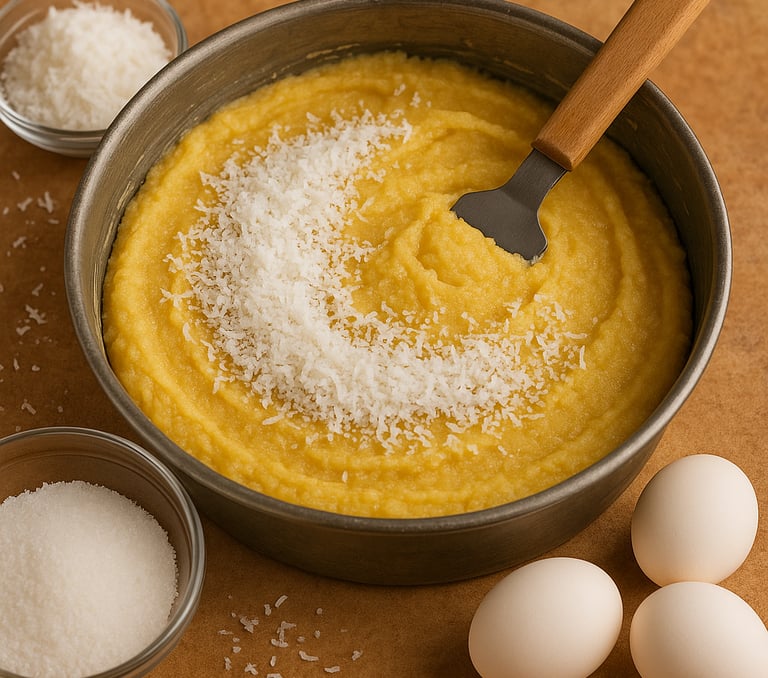Goan Baath Cake
A Treasured Semolina Delight from India's Coastal Paradise
KITCHEN FLAVORS
Wandering Armenian
7/19/20253 min read


Goan Baath Cake: A Treasured Semolina Delight from India's Coastal Paradise
Introduction
As a former aid worker who has wandered through countless villages and cities, I've discovered that the most profound stories are often told through food. This Goan Baath cake, with its tender crumb and coconut-kissed sweetness, represents the beautiful fusion of Portuguese and Indian culinary traditions. Its gentle flavors and humble ingredients remind us that extraordinary experiences often come from the simplest moments shared around a table.
History of the Cuisine
Goan Baath cake emerged from the rich culinary tapestry of Goa, where Portuguese colonizers and local Konkani communities created a unique fusion cuisine beginning in the 16th century. This beloved cake represents the harmonious blend of European baking techniques with indigenous Indian ingredients like coconut and semolina.
During the Portuguese era (1510-1961), Goan households adapted European cake-making methods to incorporate locally abundant coconuts and semolina, creating affordable yet delicious desserts. The word "Baath" derives from the Konkani term for rice, though this cake uses semolina instead, reflecting the resourcefulness of Goan cooks who substituted readily available ingredients.
This cake became a staple in Goan Catholic households, often prepared for feast days and family gatherings. Its significance extends beyond mere sustenance—it represents the resilience and creativity of a community that transformed colonial influences into something uniquely their own, preserving tradition while embracing innovation.
Ingredients and Quantities
1 cup fine semolina (160g)
2 cups fresh finely grated coconut, lightly packed (160g)
3/4 cup fine sugar (170g)
2 large eggs
2 tsp baking powder
1/4 cup coconut oil or butter
1/2 cup milk or coconut milk
1/2 tsp salt
1 tsp vanilla essence
Preparation Process
Preparation
Bring all ingredients to room temperature before making the batter
Butter or oil an 8" x 8" square cake pan or line with parchment paper
Making the Batter
Cream the butter/oil with sugar until light and airy
Add eggs one by one, beating until pale yellow and fluffy
Mix in vanilla essence
In a separate bowl, combine semolina with baking powder, then stir in coconut
Fold half the dry mixture into the egg mixture
Add half the coconut milk/milk and stir to combine
Fold in remaining dry mixture
If batter appears too dry, add remaining liquid (consistency should be dropping, not pouring)
Transfer to baking pan and level the top
Cover tightly and rest 6 hours to overnight in the refrigerator
Baking
Remove cake pan from refrigerator
Position oven rack slightly below centre and preheat to 325°F (163°C)
Let batter rest on counter while oven preheats
Bake 40-50 minutes until toothpick inserted in centre comes out clean and top is evenly browned
Cool completely on rack before slicing
Nutrition Content (Per Serving - 9 servings)
Calories: 285
Carbohydrates: 38g
Protein: 6g
Fat: 12g
Fiber: 3g
Sugar: 20g
Calcium: 95mg (from coconut)
Iron: 1.2mg (from semolina)
Note: High in healthy fats from coconut, moderate protein from eggs, and provides sustained energy from semolina.
Pro Variation Tips
Flavor Enhancements:
Add 1 tsp cardamom powder for aromatic warmth
Substitute 1/4 cup sugar with jaggery for deeper flavor
Include 2 tbsp cashew pieces for added texture
Dietary Adaptations:
Vegan: Replace eggs with 1/2 cup applesauce or mashed banana
Dairy-Free: Use coconut oil and coconut milk exclusively
Gluten-Conscious: Semolina is naturally gluten-free when certified
Texture Variations:
For denser cake: Reduce liquid by 2 tbsp
For lighter texture: Separate eggs, beat whites to soft peaks, fold in last
Add 1 tbsp lemon zest for citrusy brightness
Serving Suggestions:
Serve with coconut ice cream or fresh tropical fruits
Dust with powdered sugar before serving
Pair with masala chai for authentic experience
Concluding Thoughts
Like the communities I served across distant lands, this humble cake teaches us that patience transforms simple ingredients into something extraordinary. The overnight rest allows flavors to meld, much like how our experiences shape us over time. In sharing this recipe, I'm reminded of Ecclesiastes 3:1—"To everything there is a season, and a time to every purpose under heaven"—for in both baking and life, timing brings forth the sweetest results.

